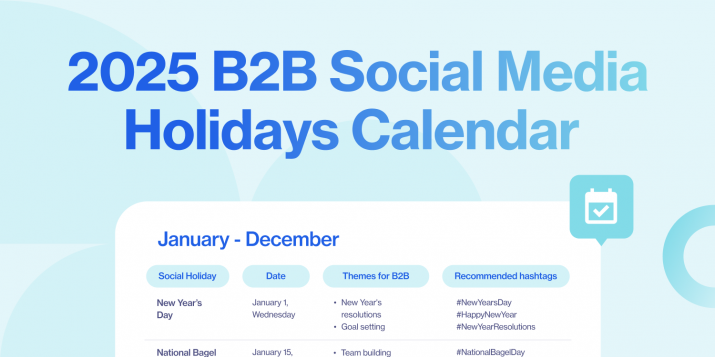
5 Ways to drive revenue with your B2B social media strategy
Table of contents
Social media is not just about creating a buzz; it can be a powerful tool for strategically influencing your customers at every stage of the sales funnel. While many businesses recognize the importance of maintaining a social media presence, the full potential of these platforms in driving revenue often goes overlooked. By incorporating social media into a comprehensive revenue generation strategy, B2B enterprises can deepen connections with their target audience and simultaneously boost sales.
In our recent webinar, Karen Tran, a Principal Analyst specializing in marketing executive strategies at Forrester, offers invaluable insights on how B2B organizations can harness the true power of social media to not only enhance their visibility but also drive substantial sales growth.
Read on to discover our top five takeaways from the webinar.
Jump ahead
- Create clear social media goals
- Prioritize employee advocacy
- Leverage social media intent signals
- Balance brand awareness with demand creation
- Create brand experiences on social media
- Check out the webinar to learn more
1. Create clear social media goals
The key to a successful social media strategy lies in clearly defined goals and measurable KPIs that align with broader business objectives. Often, our social media efforts lack direction due to the absence of clear goals, a common challenge observed across organizations of all sizes. Forrester’s customer life cycle framework for social media, comprising seven stages, emphasizes the cyclical and non-linear nature of customer-brand relationships. Social objectives can span one or multiple stages, allowing businesses to strategically plan their engagement throughout the customer journey.
To measure the effectiveness of social media initiatives, you should identify specific KPIs aligned with the targeted customer life cycle stages. In the early phases, goals may focus on creating awareness and driving consideration, with corresponding KPIs such as follower count, impressions, likes, click-through rates, web page visits, and time spent on the site.
Most importantly, organizations need a well-defined operations model that integrates social strategy with organizational enablement, ensuring alignment with overall business strategy and goals. The Forrester social operations model outlines five stages – prepare, listen, plan, engage, and measure – supported by foundational elements of business strategy, guiding effective social program management and measurement.
2. Prioritize employee advocacy
If you haven’t implemented an employee advocacy program yet, 2024 is the year you should make it happen. Creating an employee advocacy program is a strategic move for brands seeking to extend their reach and foster authentic relationships with their audience by tapping into the beauty of human connection. While brand accounts and handles are essential for deploying programs, the real power lies in amplifying messages and content through the people who make up your organization–employees, customers, and partners. After all, people trust other people’s opinions more than they trust faceless corporations.
Employee advocacy programs go beyond the traditional scope of brand programs, addressing a diverse range of audience types, including your buyers, employees, customers, and partners. These are the very audiences with whom relationships are established. Through employee advocacy, your employees can post content related to various business objectives, such as the sales funnel, marketing funnel, recruiting process, or even an investor funnel. By aligning employee advocacy with these relationship journeys, your brand can not only enhance its reputation but also create a more comprehensive and impactful engagement across diverse audience segments.
Recommended for further reading
3. Leverage social media intent signals
Integrating social intent signals into your marketing and sales strategies isn’t just a smart move; it’s a game-changer for understanding your audience and sparking genuine interest in your products or services. Your customer’s active intent shines through as they engage with you on social media, helping you identify those genuinely interested in building a deeper connection. Social media touchpoints and outreach become key in connecting with your customers throughout their unique journeys.
When you capture social signals such as follows, likes, and engagement using a social media management platform and blend them with marketing automation, you’re not just collecting data – you’re empowering your sales teams with valuable insights into real people and their readiness to buy. The strategic use of intent data allows you to identify key accounts, nurture them with content that speaks directly to their needs, and guide sales conversations to closed-won.
4. Balance brand awareness with demand creation
Balancing between brand awareness and demand generation is a critical aspect of effective social media programs. But every marketer knows that this is often easier said than done. While the overarching focus tends to be on demand, it’s essential to strike a balance that involves cultivating brand experiences, as they are integral to demand creation and capture. Don’t make your buyers feel constantly sold to. Instead, emphasize creating experiences that nurture their relationship with your brand.
For successful demand creation, a variety of engaging content such as educational materials, webinars, thought leadership pieces and live-streaming events should be created. The key is to tailor this content to specific audiences within a unified campaign. Identifying your audience’s needs or pain points is central to success, and addressing these through a consistent series of content and messaging is crucial. The challenge often lies in maintaining this consistency and delivering genuine thought leadership that sets your brand apart.
To execute targeted demand creation programs effectively, start with a well-defined buyer persona and a robust content plan that showcases your company’s unique perspective. Thought leadership pillars should be woven into the content, addressing your buyer persona’s interests and pain points while standing out creatively. Your social team’s adaptability in reimagining content for various social formats becomes a significant opportunity for innovation and impact.
5. Create brand experiences on social media
Marketers often understand the significance of brand awareness but underestimate the pivotal role it plays in generating sales. In fact, brand reputation stands as the third primary factor influencing B2B buying decisions, especially among tech-savvy “B2B early decision-makers” who prioritize a superior customer experience.
This is exactly where social media comes into play. Social media programs, when executed strategically, play a vital role in shaping brand experiences for complex buying groups, and various buyer personas. Social media touchpoints become critical as your customers move through self-guided buyer journeys, enabling you to connect meaningfully with your audience and enhance trust in your brand. The ability to connect with your audience at every stage of the funnel not only fortifies demand programs but also results in an organic flow of opportunities and accelerated deal closures.
Brand relationships evolve through three key reputational components: awareness, perception, and preference. Progressing through these levels represents a journey of deepening connections and increasing commitment, beginning with basic recognition and extending toward validation, preference, loyalty, and advocacy.
Check out the webinar to learn more
Your social media strategy should take center stage in your marketing and demand generation efforts. Implementing the insights provided above empowers you to craft a strategic and efficient social media plan that not only propels leads through the sales funnel but also evolves into a robust revenue generation engine for your organization.
Watch the full webinar to gain more valuable insights on driving revenue with your B2B social media strategy.




